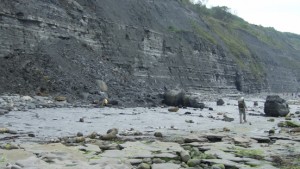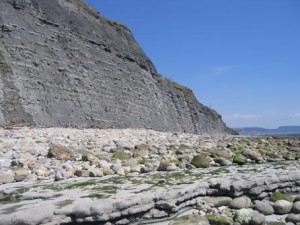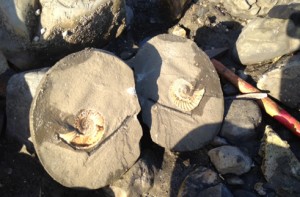Low Tides Attract Fossil Hunters to the Coast
Low Tides and Longer Days Bring Out the Fossil Hunters
Spring is in the air, it is time to dust off the overalls, get out the geological hammers, the sturdy boots, the safety goggles and the trusty high visibility clothing and to once again indulge in the hobby of fossil collecting. At this time of year, the weather is getting a little milder, the worst of the winter storms are over and the bad weather will have eroded more exciting finds out of cliffs and onto beaches, making fossils much easier to obtain, and the low tides will attract many fossil hunters.
Fossil Hunters
Beaches can be a great place to find fossils. Wave action exposes fossils on the shoreline and helps to erode rocks and fossils out of any overhanging cliffs. Many exciting finds, even dinosaurs have been found after a careful examination of the rocks on the shore.
In particular, spring tides can be a blessing for any keen fossil hunter. Spring tides occur just after a new and full moon and they mark the greatest difference between high and low water. It is the very low tides that can make the difference allowing fossil hunters to access parts of the shoreline not normally exposed. The high tides can have an effect of scouring the beach, especially if there are plenty of pebbles and gravel available. The low tide/high tide combination can expose new fossil bearing rocks and permit some exciting finds to be made.
Time for some Fossil Hunting

Picture credit: Everything Dinosaur.
Naturally, precautions should be taken. For a modest investment, a local tide timetable can be purchased. This provides invaluable information in the form of a set of tables, usually broken down into calendar months that show the time of the low tide and the time of the high tide for any given day. Armed with this knowledge, you can venture onto the beach and exploit the shoreline at the low tide, whilst remaining confident that you will not put yourself into harm’s way with a rising tide, threatening to cut you off.
Sensible Precautions
Another sensible precaution before venturing onto the beach to look for fossils is to let someone know what time you will be expected back. A mobile phone is useful in case you need to change you plans in mid trip, but it is still good advice to inform someone as to when you are likely to return. If it is possible, bring a friend along to help you search. This is much safer than venturing out onto the beach or around the bottom of cliffs on your own. Two pairs of eyes are better than one when it comes to looking for fossils and it is always useful to have an extra pair of hands to help you carry your discoveries back home.
At low tide parts of the seabed not normally exposed to the air are available for you to explore. After the winter storms, some large rocks may have been washed a long way down the beach and into the far reaches of the tidal zone. This can lead to some interesting finds, especially if you are amongst the first to venture out. It is also fascinating to see the beach at this time of year, in the early morning light it can look quite atmospheric and even though you may have visited the location on numerous occasions a low tide can make even the most mundane of beach views look entirely different.
A View of the Beach at Low Tide (Dorset, England)

Picture credit: Everything Dinosaur.
When exploring the top of the beach, near to the cliff bottoms, it is best to be cautious and to look out for any signs of a potential rock fall. Sometimes, speaking to locals can give fossil hunters an idea of how dangerous any cliffs might be and the frequency of land slips and rock falls. If warning signs have been posted up then they are there for a very good reason and they must be heeded at all times.
Fossils can be found on many parts of Britain’s coastline. A geological map will provide information on the age of rocks and indications as to whether or not they are likely to contain fossils. There are many excellent guides that can be purchased for a small fee and plenty of other information resources available both on-line and off-line. To get the most out of any visit to a beach to search for fossils it is best to do some reading and research before hand.
For models and replicas of iconic animals from the fossil record such as ammonites, ichthyosaurs and belemnites: CollectA Prehistoric Life Models.
Unfortunately, the weather cannot be guaranteed, so it is always a good idea take some waterproof clothing, there is nothing more frustrating than having to abandon a fossil hunting trip because rain gear was forgotten and the weather has taken a turn for the worse. Sensible shoes are a must, even on the driest and sunniest of days. A decent pair of walking boots is a sound investment for anyone with an interest in fossil collecting, alternatively, stout wellington boots can be worn.
For further information and advice about fossil hunting: Email Everything Dinosaur.
When searching for fossils on a low tide, it is worth remembering that many of the exposed rocks on the beach will be covered by seaweed, this can be extremely slippy and great care must be taken when traversing rocky areas. A strong walking stick can be of assistance as can a rucksack as keeping things in a back pack enables you to have your hands free to help with clambering over any particularly large obstacles.
Fossil Hunting
If a geology hammer is to be used, perhaps to crack open a nodule searching for ammonites or such like, it is a very sensible precaution to slip on a pair of safety goggles. Rock shards and other debris could fly up as you strike the surface of the rock and the goggles help protect your eyes. It is certainly well worth while cracking a few nodules on certain beaches, such as those public beaches in Dorset that make up part of southern England’s Jurassic coast. Many of these large nodules contain ammonite fossils and if you are lucky you might be able to find your own ammonite specimen.
At Low Tide Ammonites Appear

Picture credit: Brandon Lennon
The above picture shows a super ammonite – Asteroceras confusum found by Lyme Regis fossil expert Brandon Lennon. A superb specimen collected at low tide.
With fossil hunting a few hours on the beach can result in some amazing and fascinating additions to your fossil collection. To get the very best out of the spring low tides, we suggest you find out if there is a local fossil expert who conducts organised trips, let an expert take you on a fossil walk and help you to discover some truly fascinating natural wonders.
To read more about guided fossil walks around Lyme Regis: Guided Fossil Walks with Brandon Lennon.

